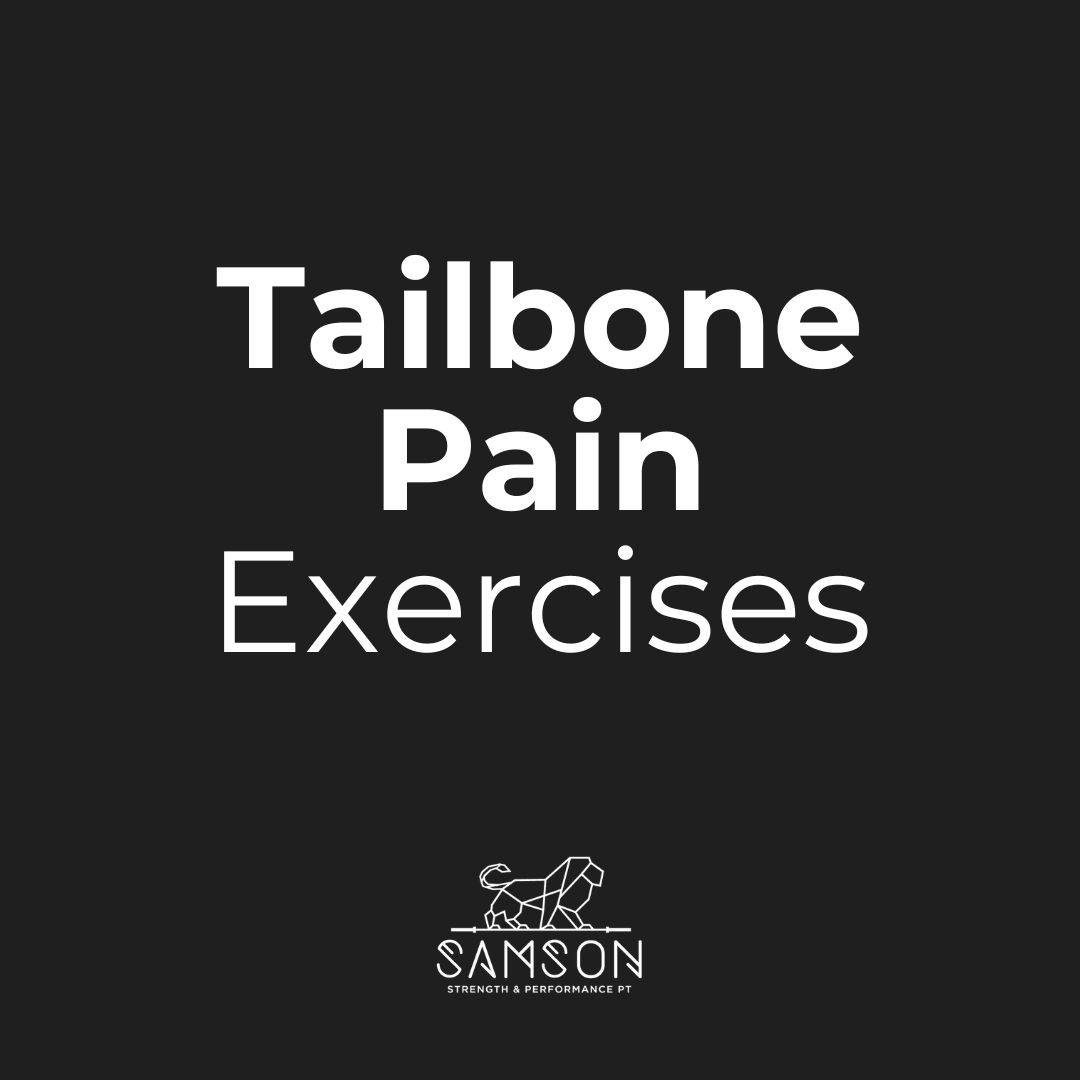Tailbone Pain Exercises: What you can do to relieve the pain in your butt
Tailbone Pain Exercises: What you can do to relieve the pain in your butt
Tailbone pain, or coccydynia, can be an incredibly painful condition, disrupting daily activities and making it difficult to sit, stand, or even lie down for extended periods of time. This condition typically starts from injury, prolonged sitting, or certain medical conditions, but the good news is that several exercises can help alleviate the discomfort. Recent research has shed light on the most effective ways to manage and even reduce tailbone pain, providing relief to many people who suffer from this issue.
Understanding Tailbone Pain (Coccydynia)
Before we dive into our favorite tailbone pain exercises, it's important to understand the root causes of tailbone pain. The coccyx, or tailbone, is located at the bottom of the spine, and pain in this area can result from a variety of factors:
Trauma: Falls or direct blows to the coccyx.
Postural Problems: Poor sitting posture can put excessive pressure on the tailbone.
Repetitive Stress: Activities like cycling or prolonged sitting can stress the coccyx over time.
Pregnancy: Women may experience tailbone pain during or after childbirth.
Obesity: Extra weight can increase pressure on the coccyx, exacerbating pain.
Tailbone Pain Exercises: Get Some Relief
1. Pelvic Tilt
The pelvic tilt is a simple yet effective exercise to relieve tailbone pain. This movement helps engage the lower back and abdominal muscles, which support the spine and pelvic region.
How to do it:
Lie on your back with your knees bent and feet flat on the floor.
Tighten your abdominal muscles and gently tilt your pelvis, pressing your lower back into the floor.
Hold for a few seconds, then relax.
Repeat 10–15 times.
Research Insight: A study published in the Journal of Physical Therapy Science (2019) found that exercises involving pelvic tilts significantly reduce pain in individuals with lower back and coccydynia pain by improving core stability.
2. Bridges
The bridge exercise is designed to strengthen the glutes and lower back muscles. These muscles play an essential role in supporting the pelvis and tailbone, helping to reduce pain by alleviating pressure.
How to do it:
Lie on your back with knees bent and feet flat on the floor.
As you exhale, tighten your core and glute muscles and lift your hips off the floor to form a straight line from your knees to your shoulders.
Lower your hips back to the floor.
Perform 3 x 8-10 repetitions.
Research Insight: According to a 2020 study in the Journal of Bodywork and Movement Therapies, strengthening exercises like bridges improve pelvic stability and posture, which can alleviate tailbone pain. The research specifically found that these exercises help by reducing pressure on the coccyx during sitting.
3. Knee-to-Chest Stretch → Happy Babies
This stretch targets the lower back and hip muscles, helping to relieve tension around the tailbone area. Stretching tight muscles around the pelvis and lower back can ease the discomfort associated with coccydynia.
How to do it:
Lie on your back with knees bent and feet flat on the floor.
Bring one knee toward your chest, keeping your other foot flat on the floor.
Hold the stretch for 20–30 seconds, then switch legs.
For happy babies, bring both knees towards the chest and pull them towards each side. Grab the ankles or bottom of the feet to enhance the stretch
Repeat 2–3 times per leg.
Research Insight: A study in The Spine Journal (2018) demonstrated that stretching exercises targeting the lower back and hips improve mobility and reduce pain in people with coccydynia. The knee-to-chest stretch, in particular, was shown to relieve tension in the pelvic region, thus reducing tailbone pain.
4. Cat-Cow Stretch (Spinal Flexion and Extension)
This yoga-inspired movement helps improve spinal flexibility and releases tension in the lower back and coccyx area.
How to do it:
Start on your hands and knees in a tabletop position.
Inhale as you drop your belly toward the floor (cow pose), lifting your head and tailbone.
Exhale as you round your back (cat pose), tucking your chin to your chest and drawing your tailbone inward.
Repeat this movement for 1–2 minutes.
Research Insight: A 2017 study in Complementary Therapies in Clinical Practice highlighted the benefits of spinal mobilization exercises like cat-cow stretches. The research found that such exercises increased flexibility in the spine and pelvis, providing relief for individuals suffering from tailbone pain.
5. Seated Piriformis Stretch
The piriformis muscle is located deep in the buttocks and can sometimes cause discomfort in the lower back and coccyx area if it becomes tight. Stretching this muscle can help reduce pain in the tailbone region.
How to do it:
Sit in a chair with both feet flat on the floor.
Cross one ankle over the opposite knee.
Gently lean forward, feeling the stretch in your glutes and the outer hip.
Hold for 20–30 seconds, then switch sides.
Repeat 2–3 times per side.
Research Insight: A study in Pain Medicine (2021) found that piriformis muscle tightness was linked to chronic coccydynia. Stretching the piriformis, along with other muscles in the gluteal region, significantly improved pain levels for participants.
6. Diaphragmatic Breathing (With a Focus on the Pelvic Floor)
Diaphragmatic breathing, or deep belly breathing, is an essential technique that helps relax the body and promote better pelvic floor health. The connection between diaphragmatic breathing and the pelvic floor is crucial because, during deep breathing, the diaphragm moves down as you inhale, and the pelvic floor muscles naturally engage and descend. This coordinated movement can help release tension in the pelvic region, reducing strain on the tailbone.
How to do it:
Lie on your back with your knees bent and feet flat on the floor, or sit upright with your feet flat on the ground.
Place one hand on your abdomen and the other on your chest.
Inhale deeply through your nose (4 seconds), allowing your abdomen to expand as the diaphragm moves down.
Exhale slowly through your mouth (6 seconds)
Focus on slow, deep breaths, aiming for 5-10 minutes of breathing exercises each day.
Research Insight: A 2019 study in The Journal of Women's Health Physical Therapy highlighted the importance of diaphragmatic breathing in improving pelvic floor muscle function. The study found that breath control exercises, like diaphragmatic breathing, help to relax tight pelvic floor muscles, reducing pressure on the coccyx and providing pain relief.
7. Coccyx Mobilization
Gentle coccyx mobilization techniques, often performed by physical therapists, can help reduce stiffness and improve mobility in the tailbone area. For those who are able to safely perform such techniques, they can be a part of a broader treatment plan.
How to do it:
This exercise should be done under the supervision of a qualified professional to avoid injury. The physical therapist uses manual manipulation to gently mobilize the coccyx, helping to restore normal movement and relieve pain.
Research Insight: A 2016 study in The Journal of Manual & Manipulative Therapy confirmed the effectiveness of coccygeal mobilization in patients with chronic tailbone pain. Patients who received manual mobilization showed significant improvements in both pain levels and mobility.
Additional Tips for Managing Tailbone Pain
Posture and Seating: Ensure you sit with proper posture to reduce pressure on the coccyx. Use a cushion or a donut-shaped pillow designed to relieve pressure on the tailbone while sitting. This will be a key aid in not aggravating the tailbone and continuing the pain cycle. Keep the cushion with you while you work, at a restaurant, and when you are sitting on your couch.
Avoid Prolonged Sitting: Take regular breaks to stand, stretch, and move around, especially if your daily routine involves sitting for long periods.
Massage the area with hand or a ball: Use a lacrosse or tennis ball to massage the surrounding glutes and tailbone area by partially sitting on the item and relieving the tension in the muscles.
Ice and Heat Therapy: Applying an ice pack or a warm compress to the affected area can help reduce inflammation and provide temporary relief.
Conclusion
Tailbone pain can feel debilitating, but tailbone pain exercises like pelvic tilts, bridges, and stretches targeted at the lower back and hips have been shown to offer significant relief. Recent research over the past decade has validated the effectiveness of these exercises in reducing pain and improving function for individuals suffering from coccydynia. By incorporating these exercises into a regular routine, along with maintaining good posture and seeking professional treatment when necessary, you can manage and potentially eliminate tailbone pain.
If your symptoms persist or worsen, it's always a good idea to consult with a pelvic floor physical therapist, to develop a personalized treatment plan tailored to your needs.
Looking for help with tailbone pain or pelvic floor physical therapy in Jacksonville Beach, FL?
If you’re looking for personalized, one-on-one sessions to address your tailbone pain or pelvic floor concerns, we provide pelvic health physical therapy services to women in the Jacksonville Beach area.
If you’re looking for providers who will listen to you and help you get to the root cause of your pelvic concerns, we’ve got you. We’re here to help you if you’re experiencing tailbone pain, pelvic heaviness, leaking, or are pregnant/postpartum and want to continue safely working out/running/lifting during your pregnancy and get back to your sport after birth.
Get started today by booking a discovery call.

